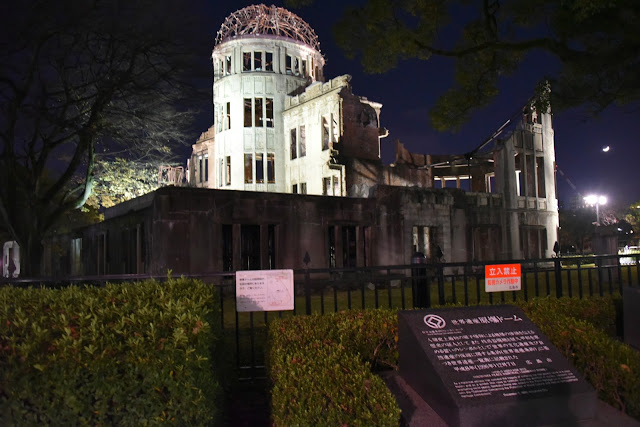The Hiroshima Peace Memorial, commonly known as the Atomic Bomb Dome or Genbaku Dome is one of the most recognizable landmarks in Japan. Originally constructed as a prefectural product exhibition hall in 1915, this severely damaged concrete building was the only structure left standing near the hypocenter of the atomic bomb which destroyed Hiroshima on 6th Aug 1945.
Not only did the building survive the atomic bomb, it also somehow managed to escape the fate of demolition during the post-war reconstruction of Hiroshima. In fact it had been preserved in more or less its original state with minor repairs done only to ensure its stability. Much of the area around it though had been re-developed as the Hiroshima Peace Memorial Park. That's where the Peace Memorial Museum, the Cenotaph and a long list of monuments to commemorate the atomic bomb victims are located.
The Atomic Bomb Dome has been designated a UNESCO World Heritage since 1996 and it draws millions of visitors annually. The Memorial Park can be very crowded in the daytime but when night falls peace and serenity returns.
To mark the 75th anniversary of the atomic bombing of Hiroshima, here are a series of photographs of the Genbaku Dome taken on a winter's night in December 2018. More of the Atomic Dome and how it survived the nuclear fires can be found in my previous post Hiroshima - 70 Years After The Atomic Bomb.
The good thing about visiting the Genbaku Dome at night was that there was hardly any body around. The usual daytime hustle and bustle was instead replaced by quietness and peace. On a cold winter's night like this everybody else was either at home or enjoying a meal of oysters, a Hiroshima specialty, at some nearby izakaya restaurant. Gone were the maddening crowd and the noise and smell of perspiration that permeated the atmosphere around the Memorial Park.
I had spent the entire day visiting the other famous Hiroshima landmark, the Itsukushima Shrine of Miyajima with friends. They were to leave Hiroshima very early the next day for Okunoshima a.k.a. Rabbit Island but did not want to miss seeing the Atomic Bomb Dome, hence the night trip to the Peace Park.
Without the distraction of other tourists, I began to see the small things that I did not notice before. The area in the vicinity of the Dome was very clean and well kept in general. The trees had mostly lost their leaves and only the bare branches pointed skywards but the flowerbeds were still in full bloom! This attested to the mild winters of western and southern Japan. There were also less vehicles on the road and the air was crisp and fresh.
On the side of the Atomic Dome facing the Hiroden tram stop, an irregularly shaped piece of granite with the kanji words 慰霊 ( irei - consoling the spirits of the deceased ) stood in front of the Dome like a giant tombstone complete with flowers and other offerings. I felt a sense of eeriness knowing that thousands had died at that exact spot decades ago. It was good that the irei memorial was there to placate the wandering souls.
The exterior of the Atomic Bomb Dome was well illuminated at night by strategically placed artificial lighting. Footpaths within the Memorial Park were also well lit. Japan has a relatively low crime rate and it is quite safe to walk around the city even at night.
Although visitors are not allowed to enter the ruins, they can still see the damage done to the building up close and the skeletal remains of the metal dome on top of the building which gave it its common name.
The Dome was constructed on the banks of the Motoyasu River ( 元安川 ) and just a hundred meters from it is the T-shaped Aioi Bridge seen in the photo above which was the aiming point for the atomic bomb on that fateful morning 75 years ago. The still air over the river made the water surface into a perfect mirror reflecting the night scenery flawlessly.
The photographs above showed the illuminated T-shaped Aioi Bridge ( 相生橋 ) and the exact T-junction used as the bombardier's aiming point. An iconic Hiroden tram could be seen speeding across the bridge. Because it was winter, two bags of salt for de-icing the roads were placed next to the pillar which has the name of the bridge mounted on it. Guess the winter can still be severe occasionally.
It is best to walk across the Aioi Bridge to the opposite bank of the Motoyasu River to see the Atomic Bomb Dome in its entirety. I could take my time to compose the photograph without worrying about other people intruding into my field of view.
 |
| The Atomic Bomb Dome in the immediate period after the bomb. Source : Hiroshima Municipal Archive |
The Genbaku Dome was eerily serene and beautiful on that cold winter's night. It stands today as a testimony to the foresight of the people of Hiroshima City to have such an iconic landmark preserved for the benefit of the future generations who may hopefully not have to experience the brutality of war like the Japanese did. As the last of the Hibakusha or atomic bomb victims pass on due to advance age or illnesses, the Atomic Dome becomes ever more important as a symbol to remind the world on nuclear disarmament ...















